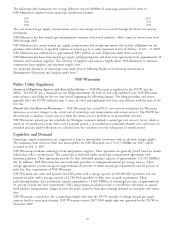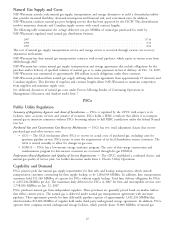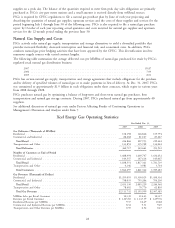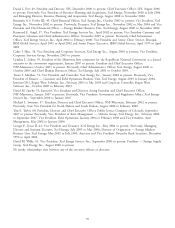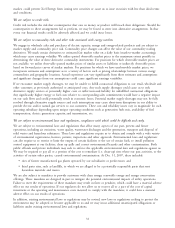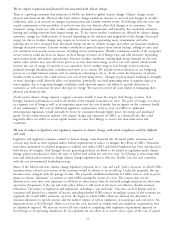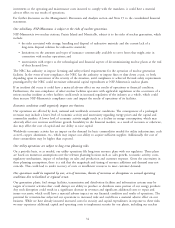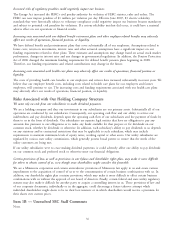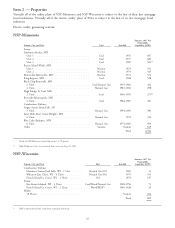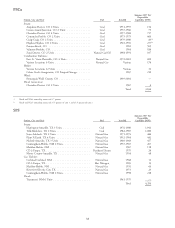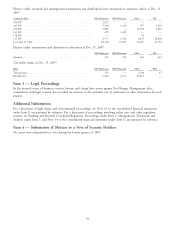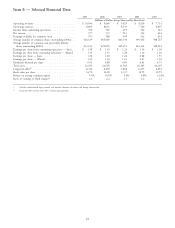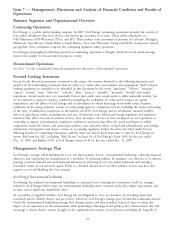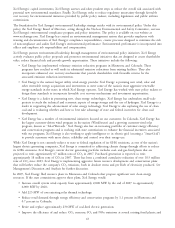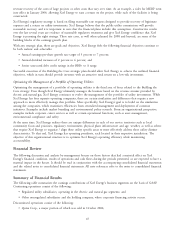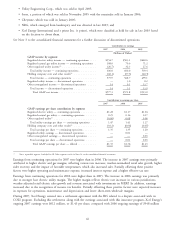Xcel Energy 2007 Annual Report Download - page 46
Download and view the complete annual report
Please find page 46 of the 2007 Xcel Energy annual report below. You can navigate through the pages in the report by either clicking on the pages listed below, or by using the keyword search tool below to find specific information within the annual report.Increased risks of regulatory penalties could negatively impact our business.
The Energy Act increased the FERC’s civil penalty authority for violation of FERC statutes, rules and orders. The
FERC can now impose penalties of $1 million per violation per day. Effective June 2007, 83 electric reliability
standards that were historically subject to voluntary compliance could negativity impact our business became mandatory
and subject to potential civil penalties for violations. If a serious reliability incident did occur, it could have a material
adverse effect on our operations or financial results.
Increasing costs associated with our defined benefit retirement plans and other employee-related benefits may adversely
affect our results of operations, financial position, or liquidity.
We have defined benefit and postretirement plans that cover substantially all of our employees. Assumptions related to
future costs, return on investments, interest rates and other actuarial assumptions have a significant impact on our
funding requirements related to these plans. These estimates and assumptions may change based on actual stock market
performance, changes in interest rates and any changes in governmental regulations. In addition, the Pension Protection
Act of 2006 changed the minimum funding requirements for defined benefit pension plans beginning in 2008.
Therefore, our funding requirements and related contributions may change in the future.
Increasing costs associated with health care plans may adversely affect our results of operations, financial position or
liquidity.
The costs of providing health care benefits to our employees and retirees have increased substantially in recent years. We
believe that our employee benefit costs, including costs related to health care plans for our employees and former
employees, will continue to rise. The increasing costs and funding requirements associated with our health care plans
may adversely affect our results of operations, financial position, or liquidity.
Risks Associated with Our Holding Company Structure
We must rely on cash from our subsidiaries to make dividend payments.
We are a holding company and thus our investments in our subsidiaries are our primary assets. Substantially all of our
operations are conducted by our subsidiaries. Consequently, our operating cash flow and our ability to service our
indebtedness and pay dividends, depends upon the operating cash flow of our subsidiaries and the payment of funds by
them to us in the form of dividends. Our subsidiaries are separate legal entities that have no obligation to pay any
amounts due pursuant to our obligations or to make any funds available for that purpose or for dividends on our
common stock, whether by dividends or otherwise. In addition, each subsidiary’s ability to pay dividends to us depends
on any statutory and/or contractual restrictions that may be applicable to such subsidiary, which may include
requirements to maintain minimum levels of equity ratios, working capital or other assets. Our utility subsidiaries are
regulated by various state utility commissions, which generally possess broad powers to ensure that the needs of the
utility customers are being met.
If our utility subsidiaries were to cease making dividend payments, it could adversely affect our ability to pay dividends
on our common stock and preferred stock or otherwise meet our financial obligations.
Certain provisions of law, as well as provisions in our bylaws and shareholder rights plan, may make it more difficult
for others to obtain control of us, even though some shareholders might consider this favorable.
We are a Minnesota corporation and certain anti-takeover provisions of Minnesota law apply to us and create various
impediments to the acquisition of control of us or to the consummation of certain business combinations with us. In
addition, our shareholder rights plan contains provisions, which may make it more difficult to effect certain business
combinations with us without the approval of our board of directors. Finally, certain federal and state utility regulatory
statutes may also make it difficult for another party to acquire a controlling interest in us. These provisions of law and
of our corporate documents, individually or in the aggregate, could discourage a future takeover attempt which
individual shareholders might deem to be in their best interests or in which shareholders would receive a premium for
their shares over current prices.
Item 1B — Unresolved SEC Staff Comments
None.
36


